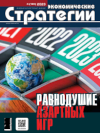Specifics of Technological Development of Russia
DOI: 10.33917/es-4.190.2023.64-71
The paper deals with the problems of ensuring the technological sovereignt y of the Russian economy, as a task set in 2022, with an emphasis on the evolutionary aspects of technological changes when considering options for government decisions. The purpose of the study is to identif y the specific characteristics of technological (innovation) dynamics with the formation of structural and sectoral policy measures corresponding to these characteristics. The result is a rationale for the coherence of the policy of new industrialization and ensuring technological sovereignt y, which requires a systemplanned approach that involves controlled structural changes in the field of basic industries and the technological base of the Russian economy. The properties of the aggregated sectors are presented, which must be taken into account when implementing the relevant structural policy. Proposals are given on the formation of structural and sectoral policy in Russia at the present stage.
References:
1. Glaz’ev S.Yu. Nanotekhnologii kak klyuchevoi faktor novogo tekhnologicheskogo uklada v ekonomike [Nanotechnologies as a Key Factor of the New Technological Order in the Economy]. Pod red. akademika RAN S.Yu. Glaz’eva i professor V.V. Kharitonova. Moscow, Trovant, 2009, 304 p.
2. Spens M. Sleduyushchaya konvergentsiya. Budushchee ekonomicheskogo rosta v mire, zhivushchem na raznykh skorostyakh [Next convergence. The Future of Economic Growth in a World Living at Different Speeds]. Moscow, Izd-vo Instituta Gaidara, 2130, 336 p.
3. Sukharev O.S. Ekonomika promyshlennosti, tekhnologii i intellektual’nykh firm [Economics of Industry, Technology, and Smart Firms]. Moscow, Lenand, 2022, 304 p.
4. Khelpman E. Zagadka ekonomicheskogo rosta [Economic Growth Mystery]. Moscow, Izd-vo Instituta Gaidara, 2011, 240 p.
5. Cheng M., Yang S., Wen Z. The effect of technological factors on industrial energy intensity in China: New evidence from the technological diversification. Sustainable
Production and Consumption, vol. 28, 2021, pp. 775–785.
6. Crafts N. The First Industrial Revolution: Resolving the Slow Growth. Rapid Industrialization Paradox. Papers and Proceedings of the Nineteenth Annual Congress of the European Economic Association. Journal of the European Economic Association, vol. 3, N 2/3, 2005, pp. 525–534.
7. Dosi G. Technical Change and Industrial Transformation: The Patterns of Industrial Dynamics. In: Technical Change and Industrial Transformation. Palgrave Macmillan, London, 1984, 338 p.
8. Franka A.G., Dalenogareb L.S., Ayala N.F. Industry 4.0 technologies: Implementation patterns in manufacturing companies. International Journal of Production
Economics, vol. 210, 2019, pp. 15–26.
9. Sukharev O.S. Izmerenie tekhnologicheskogo razvitiya: podkhody, metody, problemy i perspektivy [Measuring Technological Development: Approaches, Methods, Problems and Prospects]. Ekonomicheskie strategii, 2023, no 1, pp. 26–35, DOI: 10.33917/es-1.187.2023.26-35.
10. Sukharev O.S. Tekhnologicheskii dualizm rossiiskoi ekonomiki i strukturnaya politika novoi modeli ee rosta [Technological Dualism of the Russian Economy and Structural Policy of the New Model of Its Growth]. Vestnik IE RAN, 2023, no 1, pp. 75–89.
11. Sukharev O.S. Tekhnologicheskii regress — tupikovye prognozy v epokhu sanktsii Nauka i iskusstvo upravleniya [Technological Regression – Dead End Predictions in the Age of Sanctions Science and Art of Management]. Vestnik Instituta ekonomiki, upravleniya i prava Rossiiskogo gosudarstvennogo gumanitarnogo universiteta, 2022, no 3, pp. 114–128.
12. Nauka, innovatsii i tekhnologii [Science, Innovations and Technologies]. Federal’naya sluzhba gosudarstvennoi statistiki, available at: https://rosstat.gov.ru/statistics/science.
13. Gabardo F.A., Pereima J.B., Einloft P. The incorporation of structural change into growth theory: A historical appraisal. EconomiA, vol. 18, iss. 3, 2017, pp. 392–410.



